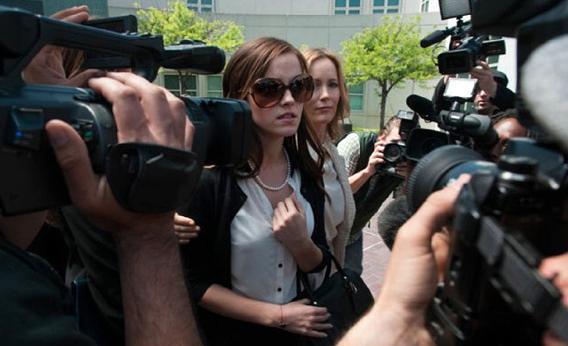Two movies opening this week—Sofia Coppola’s The Bling Ring and Seth Rogen and Evan Goldberg’s This Is the End—give us a present-day Los Angeles that’s at once comic and nightmarish, the Hollywood dream capital turned moral hellscape. For two works with such different imagined audiences and aesthetic aims, they have a surprising amount in common: Both take place largely in the sumptuous homes of real-life celebrities, some of whom appear as themselves. And both movies function at once as critiques of their protagonists’ empty, pleasure-seeking materialism and as archives of the luxury swag they’ve accumulated, whether by theft or by overpayment.
The Bling Ring, which is based on true events, follows the formation and dissolution of a gang of well-off teenage burglars who specialize in invading the houses of the young, rich, and famous: Paris Hilton, Megan Fox, and Orlando Bloom are among their targets. This Is the End, for its part, barricades a pack of actors who already are young, rich and, to varying degrees, famous—Seth Rogen, Danny McBride, Craig Robinson, Jonah Hill, Jay Baruchel—into the house of the richest and most famous of them all, James Franco, where they’ll squabble and bro-bond as they await the coming biblical apocalypse.
Sofia Coppola’s vision of the L.A. end of days may not feature giant sinkholes opening up into the Earth’s core and horned lava-demons stalking the living, but that doesn’t keep her film from being the more pessimistic of the two. The Bling Ring isn’t without humor—some of scenes involving Leslie Mann as a ditzy home-schooling mother are almost too comically broad. But Coppola’s tone overall is as bleak as it’s ever been. Her earlier portraits of celebrity-culture anomie, Lost in Translation and Somewhere, both centered on redemptive relationships that promised, however fleetingly, to save their protagonists from the spiritually barren worlds they inhabited. The Bling Ring’s version of redemption is purely accumulative: another Birkin bag, another roll of cash, another closetful of Louboutins.
The Bling Ring does focus on a central relationship: the friendship between Marc (Israel Broussard), an awkward gay kid who’s new to the tony Los Angeles suburb of Calabasas, and Rebecca (Katie Chang), a drop-dead-cool bad girl who takes him under her wing and tutors him in burglary. But without giving away what happens between Marc and Katie—or among the rest of their status-hungry circle, which includes Nicki (Emma Watson), Sam (Taissa Farmiga), Chloe (Claire Julien), and a rotating crew of tag-along rich-kid wastoids—let’s just say that friendship in these kids’ world isn’t as deeply held a value as having a kick-ass stash of drugs and couture underneath your bed.
For a movie about excess, The Bling Ring is remarkable for its spareness. It’s the most languid heist movie ever made, making ample use of silence as Coppola’s camera saunters casually from break-in to break-in, her amoral but lissome heroes bathed in creamy Southern California light. (This was the last film of the late cinematographer Harris Savides, and Coppola opens with a dedication to him.) But for all its beautifully established mood, this film remained, at least for me, curiously unsatisfying—a kind of exquisitely tasteful after-school special. What does Coppola think and feel about the fate of these bratty lost souls? What should we think and feel? Or are we inhabiting some new world where those are no longer valid questions?
This Is the End, for its part, has no problem making moral judgments on its characters. Those who are worthy get pulled into heaven by blue tractor beams, while the unworthy plunge down vast abysses into the Earth’s core—a fate that, in this movie’s world, puts a significant dent in the L.A. comedy community. In an early scene, Mindy Kaling, Aziz Ansari, and others, including a hilariously out-of-character, coke-addled Michael Cera, all meet unspeakable, comically gory fates. Left behind are Seth Rogen, James Franco, and the gang—all playing themselves, and all supposedly the best of showbiz buds. That is, until they must negotiate their own survival, not to mention their complicated friendships, resentments, and rivalries in a world whose dangers involve demon possession, unexplained beheadings, and an ax-wielding Emma Watson (another commonality between The Bling Ring and This is the End! Except for the ax.) What follows is essentially a series of sketch ideas strung together—but at least they’re consistently riotous sketches, with time left in between for a surprisingly tender investigation of the shifting bonds among the ethically challenged bros as they discover one by one that they can neither buy nor charm their way to salvation.
A.O. Scott is probably right that This Is the End represents the logical endpoint of the Apatow-bred manchild comedy: How much more of a circle jerk could Rogen and Goldberg film without risking an X rating? But if This Is the End does represent its own kind of apocalypse, at least the subgenre that gave us Superbad (also written by Rogen and Goldberg) and Pineapple Express is going out with a bang. This Is the End, true to its subject matter, is as funny as hell.
